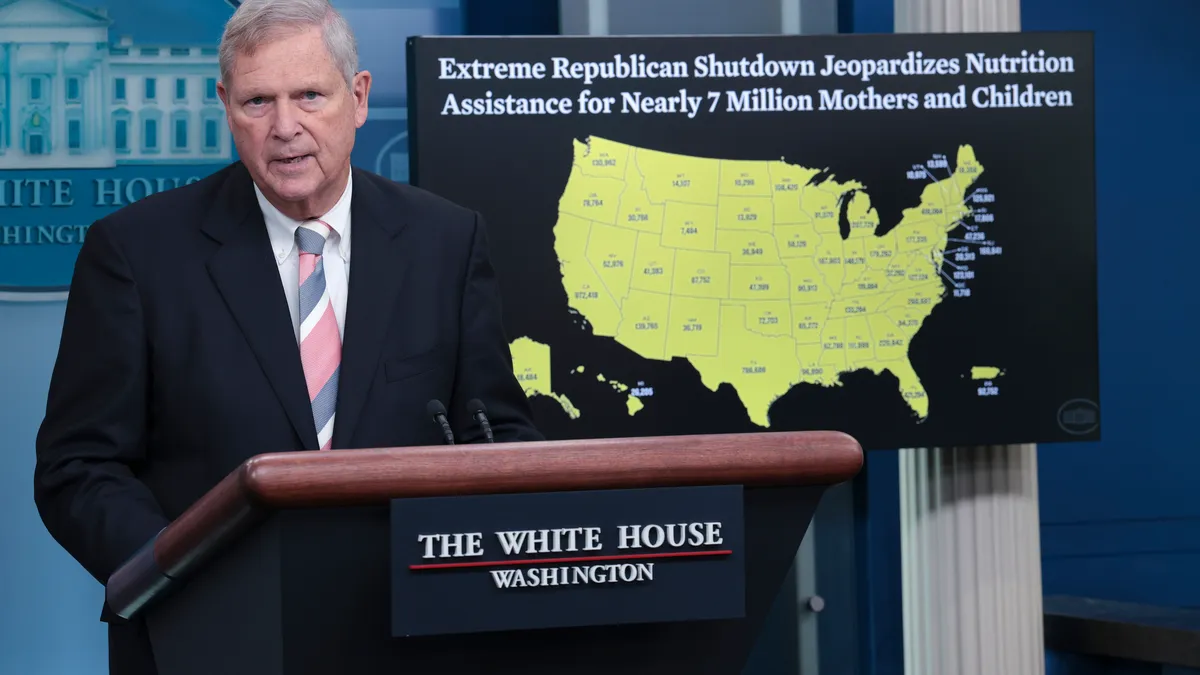Dive Brief:
-
Food assistance, commodity loans and other programs supporting farmers would be disrupted unless Congress is able to reach a spending agreement to avert a government shutdown by Sept. 30, U.S. Department of Agriculture Secretary Tom Vilsack warned Monday.
-
While Supplemental Nutrition Assistance Program benefits would continue, the Women, Infants and Children program would stop functioning immediately and affect millions of people who rely on it, Vilsack said in a White House press briefing.
-
Marketing loan programs would also cease operations in the middle of fall harvesting, which could force farmers to sell crops at lower prices, he said. Additionally, duties deemed “non-essential,” such as collecting data for crop and agricultural export reports, would stop during a lapse of funding.
Dive Insight:
Hard-right demands for deep spending cuts across federal agencies is holding up a budget agreement and raising the likely prospect of a government shutdown beginning at the end of the week. Federal government funding is set to expire at the start of the fiscal year, Oct. 1, if Congress is not able to pass a plan that the president signs into law.
The effects of a government shutdown would vary from agency to agency with certain essential programs and duties continuing without payment to workers. USDA food inspection services would operate at meat and poultry processing plants, for example, but agricultural statistics services and WIC benefits would temporarily cease.
“It’s difficult to face where we are today with an extreme House Republican effort to recklessly steer our government toward a preventable shutdown that would put many of the critical services that we care about deeply at USDA at risk,” Vilsack told reporters.
Approximately 7 million low-income women and children rely on nutritional assistance from USDA’s WIC program, and those benefits would dry up without a spending plan in place. In some cases, Vilsack said support for recipients would vanish in a matter of days.
Farmers and ranchers would also feel the effects from a shutdown. They would not be able to sign-up for marketing loan programs that allow interim financing when market prices are at harvest-time lows. The loans allow producers to delay selling their commodities until more favorable market conditions emerge, according to USDA.
“Farm service agency offices in virtually every county of this country shut down and those loans are not available,” Vilsack said.
Historically, USDA has also halted agricultural statistics programs, delaying the publication of crop progress and export reports. Without these reports, the markets cannot function properly and farmers would be left with the current pricing status quo for better or worse.
“This is a matter of real consequences when we are faced with a shutdown,” Vilsack said.
How long these shutdowns last can vary. According to U.S. data, previous shutdowns have been as short as a day or surpassed a month before Congress restored funding.
SNAP benefits that allow low-income consumers to buy food from grocery stores are funded by the farm bill through the month of October. If the shutdown extends beyond that, Vilsack warned “there would be some serious consequences to SNAP,” though experts have said the USDA does have the authority to continue issuing benefits.











